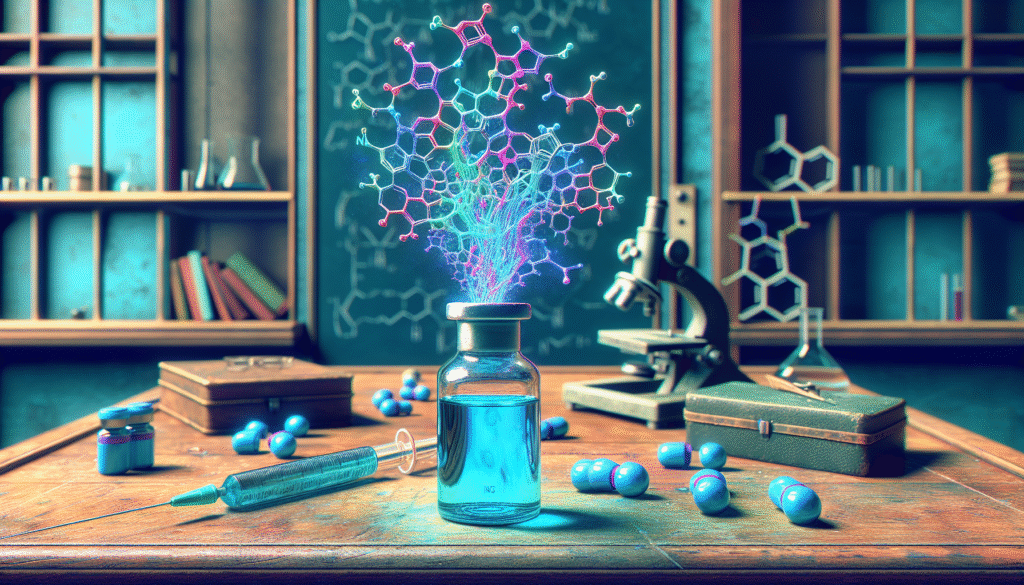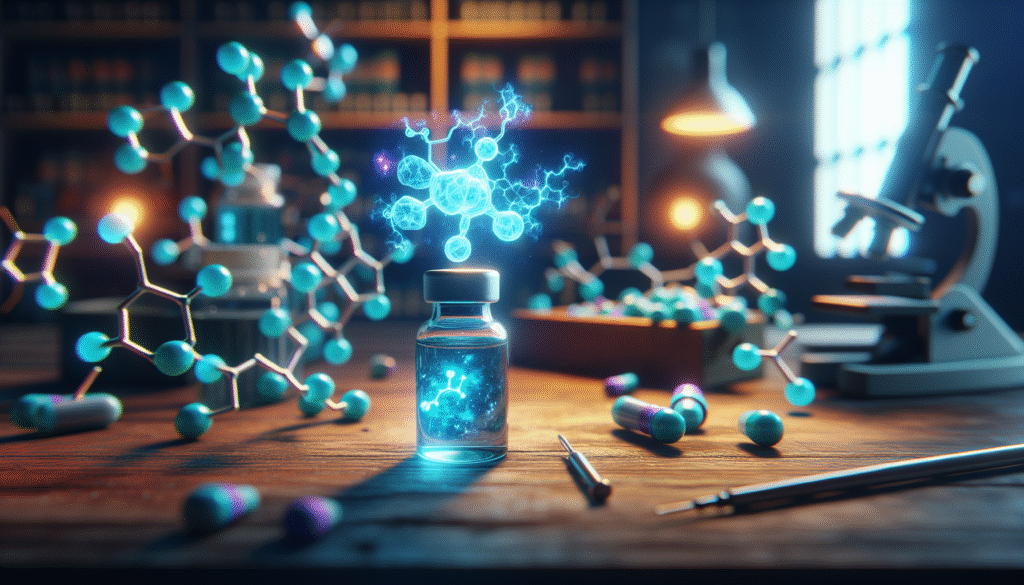
What impact could a compound like Methylene Blue have on the complex world of neurotransmitter levels in our brains? The answer lies in understanding the intricate relationship between this dye, often associated with biological research and treatment, and the chemical messengers that define our neurological function.
Understanding Methylene Blue
Methylene Blue is a synthetic compound known for its applications in medicine and biology. Originally developed as a dye, it has found various uses, particularly in the fields of microbiology and psychiatry. When Methylene Blue enters the body, it undergoes significant metabolic changes, leading to various physiological effects. Grasping the nature of Methylene Blue is crucial in comprehending its influence on neurotransmitters.
Historical Context
Methylene Blue was first synthesized in the late 19th century and was primarily used as a dye. Its journey from textile to medicinal use highlights its unique properties. With advancements in scientific research, particularly in the early 20th century, Methylene Blue was found to possess therapeutic properties, which paved the way for its application in the treatment of conditions such as malaria and methemoglobinemia.
Chemical Composition
The chemical formula of Methylene Blue is C16H18ClN3S. Its structure contains various functional groups, including a thiazine moiety and a positively charged nitrogen atom. This structure is integral to its interaction with the body, influencing how it crosses biological barriers and interacts with cellular components.
Neurotransmitters: The Brain’s Communication Network
Neurotransmitters play a pivotal role in communicating signals throughout the nervous system. These chemical messengers enable neurons to communicate, influencing everything from mood to motor function. Understanding their classification and functions is essential to grasp how Methylene Blue may affect them.
Classification of Neurotransmitters
Neurotransmitters can be broadly categorized into two groups:
- Excitatory Neurotransmitters: These promote the firing of neurons, facilitating communication between brain cells. Common examples include glutamate and dopamine.
- Inhibitory Neurotransmitters: These reduce neuronal firing, calming the nervous system. Prominent examples are gamma-aminobutyric acid (GABA) and serotonin.
Understanding this dichotomy is essential as Methylene Blue’s effects on these neurotransmitters can influence mood regulation, cognitive function, and overall mental health.
Major Neurotransmitters and Their Functions
Here are some of the key neurotransmitters and their primary functions:
| Neurotransmitter | Function |
|---|---|
| Dopamine | Involved in pleasure, reward, and motivation. |
| Serotonin | Regulates mood, sleep, and appetite. |
| GABA | Acts as the primary inhibitory neurotransmitter, promoting calm and relaxation. |
| Glutamate | The main excitatory neurotransmitter, crucial for cognitive functions like learning and memory. |
| Norepinephrine | Plays a role in attention and responding actions. |
| Acetylcholine | Involved in muscle activation and memory. |
Understanding these neurotransmitters will enable you to appreciate the potential implications of Methylene Blue on neurological health.

The Mechanism of Action of Methylene Blue
To comprehend the influence of Methylene Blue on neurotransmitter levels, an exploration of its mechanism of action is necessary. This compound acts through several pathways, including its role as an electron carrier and its antioxidant properties.
Mitochondrial Function
Methylene Blue has been shown to enhance mitochondrial function. Mitochondria, often referred to as the powerhouses of the cell, are vital for energy production. Methylene Blue can facilitate the transfer of electrons in the mitochondrial respiratory chain, improving ATP production. This process is critical because a balanced energy supply directly impacts neurotransmitter synthesis and release.
Antioxidant Properties
The antioxidant qualities of Methylene Blue play a crucial role in its neuroprotective effects. By neutralizing free radicals, Methylene Blue may protect neuronal health, thus maintaining optimal levels of neurotransmitters. Oxidative stress can disrupt neurotransmitter balance, so any compound that mitigates this stress is of significant interest in neurological research.
The Interaction Between Methylene Blue and Neurotransmitter Levels
Methylene Blue’s interaction with neurotransmitter levels is multi-dimensional. Its effects can stimulate or inhibit neurotransmitter production and release, leading to various outcomes based on the clinical context.
Effects on Dopamine
Dopamine is often associated with reward and motivation. Some studies have suggested that Methylene Blue may enhance dopamine levels indirectly. By improving mitochondrial function and possibly influencing the dopamine synthesis pathway, Methylene Blue could elevate dopamine availability, leading to improved mood and cognitive function.
Effects on Serotonin
Serotonin is crucial for mood regulation, and its levels are often targeted in the treatment of depression. Methylene Blue may influence serotonin metabolism; however, the exact mechanisms remain unclear. Some evidence suggests that Methylene Blue can enhance serotonin receptor activity, thereby improving the overall serotonergic signaling in the brain.
Influence on GABA Levels
GABA, an inhibitory neurotransmitter, is vital for counterbalancing excitatory signals in the brain. Methylene Blue’s role in promoting antioxidant activity may protect GABAergic neurons from oxidative damage. While there is limited direct evidence of Methylene Blue affecting GABA levels, its neuroprotective properties could indirectly support optimal GABA function.
Glutamate Modulation
Given that glutamate is the primary excitatory neurotransmitter, its balance is crucial for neurophysiological health. Methylene Blue’s influence on glutamate levels may require further research. However, enhancing mitochondrial function can contribute to the overall neuronal health that supports balanced glutamate levels.

Clinical Applications of Methylene Blue in Neurology
Methylene Blue is used in various clinical settings, particularly in neurology and psychiatry. It is essential to comprehend the therapeutic potential and the underlying mechanisms that lead to varying outcomes across different health conditions.
Alzheimer’s Disease and Dementia
Methylene Blue has gained attention as a potential treatment for Alzheimer’s disease and other forms of dementia. Due to its capacity to enhance mitochondrial function and reduce oxidative stress, Methylene Blue might help to improve cognitive function and slow disease progression, influencing neurotransmitter levels related to memory and learning.
Depression and Mood Disorders
Given Methylene Blue’s impact on serotonin and dopamine, its role in treating mood disorders presents promising avenues for exploration. Some clinical trials have shown that Methylene Blue could enhance the effectiveness of traditional antidepressants, potentially offering new hope for individuals resistant to standard treatments.
Pain Management
Another area where Methylene Blue may excel is pain management. Its properties can contribute to reducing inflammation and providing analgesic effects, possibly modulating the release of neurotransmitters involved in pain perception.
Anxiety Disorders
By potentially influencing GABA and serotonin levels, Methylene Blue may offer therapeutic benefits in anxiety disorders. Although more research is needed, its neuroprotective and neurochemical modulation roles make it an intriguing subject for further investigation.
Safety and Dosage Considerations
While Methylene Blue possesses many beneficial properties, it is vital to approach its use understanding possible side effects and safe dosages. Awareness of potential interactions and contraindications is paramount.
Side Effects
Common side effects of Methylene Blue use include:
- Nausea
- Dizziness
- Headache
- Allergic reactions in sensitive individuals
Severe side effects involve interference with serotonin levels, which could lead to serotonin syndrome when combined with other serotonergic medications.
Recommended Dosages
The appropriate dosage of Methylene Blue can vary depending on the intended use. Self-administration without professional guidance is not advisable. Methylene Blue is typically administered at low doses for neurological conditions, often in management protocols.
Future Insights and Research Directions
As with many compounds in the realm of medicine, further research on Methylene Blue and its effects on neurotransmitter levels is essential. While initial findings are promising, a comprehensive understanding requires rigorous clinical trials, especially to ascertain long-term effects and potential interactions with other treatments.
Need for Longitudinal Studies
Longitudinal studies could provide significant insights into the long-term effects of Methylene Blue on neurotransmitter levels. By tracking participant outcomes over extended periods, researchers can identify sustained benefits or risks associated with continued use.
Mechanistic Studies
In-depth mechanistic studies investigating how Methylene Blue interacts with neurotransmitter pathways will be valuable. Understanding the intricate biochemical signaling pathways will pave the way for more targeted therapeutic interventions.
Conclusion
The connection between Methylene Blue and neurotransmitter levels unveils a fascinating dimension of neuropharmacology. By enhancing mitochondrial function, acting as an antioxidant, and possibly modulating neurotransmitter synthesis, Methylene Blue signifies a potential therapeutic ally in various neurological and psychological conditions.
As you consider the implications of Methylene Blue in your health journey or academic pursuits, acknowledge the ongoing research necessary to elucidate its full potential. The complexity of the brain holds many mysteries, but compounds like Methylene Blue may offer exciting avenues for exploration and discovery in neurological health. Your understanding of these mechanisms will undoubtedly enrich your perspective on mental health and cognitive function.
Long-term studies and further exploration into Methylene Blue’s effectiveness and safety in various clinical contexts are essential steps in unlocking its full potential as a neurological treatment.